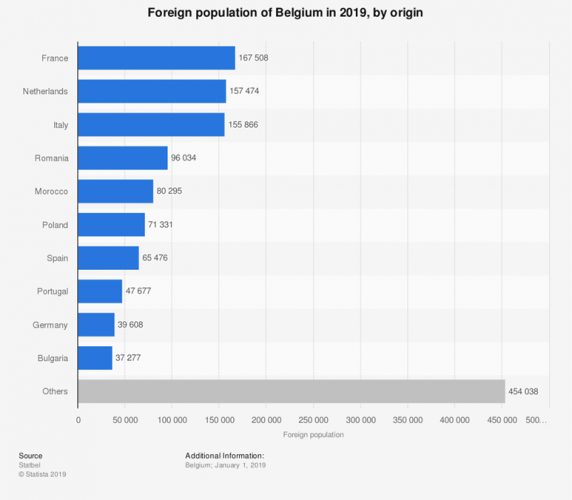[astra_breadcrumb]
Migration in Belgium
Kamille Debacker
Belgian migration history
From 1830, marking the establishment of an independent kingdom of Belgium, until the First World War, Belgium was primarily a country of emigration. A large proportion of the population migrated to France, the United States, or Canada. The reasons for migration were lack of decent work, land expropriation, and economic opportunities abroad (Morelli 1998).
In the 20th century, economic need was no longer the basis for emigration. Armed conflicts, the two world wars in particular, drove 1–2 million people to seek refuge outside Belgium.
Immigration to Belgium began mainly with migrant workers from neighbouring countries, Eastern Europe, and Italy, before the First World War. Immigration to Belgium increased significantly in the interwar era, mainly because the Belgian government organised recruitment campaigns to promote the country’s growing coal industry among foreign workers (Myria 2015). In 1930, the Belgian mining industry employed about 30,000 foreign workers, 17% of all the country’s miners (Caestecker & Morelli 2010).
The first big wave of immigration started after World War II. In 1946, the Belgian government concluded a bilateral agreement with several Mediterranean countries to attract migrant workers. Their aim was to meet the acute shortage of labour in the mining and steel industries. In the 1950s and 1960s, the first guest workers from Italy and Spain came to Belgium. Within a decade, more than 111,000 Italians came to Belgium as migrant workers (Myria 2015). In 1956, 136 Italian miners died in a mining disaster in Marcinelle, Wallonia. This slowed down the immigration of Italian workers. Belgium refused to accept Italy’s demand for better work conditions for its nationals, and since then it has recruited labour migrants from Spain, Greece, Morocco, and Turkey (Martiniello & Rea 2003).
Initially, the Belgian government stimulated family reunification (Geldof 2015). From 1970, in response to economic crisis, this policy has been officially suspended, but that has not meant the end of immigration (Martiniello & Rea 2003). Family reunification was one of the main motives for migrating – guest workers could resettle their families with them. People in this group were part of the first generation. In addition, marriage-related migration and political asylum were important motives to migrate. With the gradual enlargement of the European Union, labour migration still remains possible within Europe (Geldof 2015).
From the 1980s–1990s onward, there has been a migratory flow of highly skilled people, asylum-seekers, and illegal immigrants from Eastern Europe, the Middle East, Asia, Latin America, and Africa. Of the Sub-Saharan migrants, Congolese and Rwandans form the largest group. Instability in the country of origin and historical colonial ties with Belgium are two reasons for migration (Berdai 2005). In addition, globalisation and growing international trade led to economic migration (Geldof 2015).
Tracking migration, marriage, and labour migration within the EU continue to be the main types of migration in the 21st century. In response to tightening of legislation on family reunification, the number of asylum applications has been falling since 2011. In 2015, the number of applications showed an increase again, mainly due to the arrival of applicants for international protection from the Middle East (Geldof 2015).
Demographics of foreign population of Belgium
According to Statbel data, Belgium had 1,391,425 persons of foreign nationality in 2019, making up 12.2% of the country’s total population. In 2009, foreign nationals accounted for 9.4% of Belgium’s population, or 1,013,260 people (Statbel 2019).
In 2019, 66.5% of the immigrants in Belgium were from the European Union. French, Dutch, Italian, Romanian, and Moroccan people were the most strongly represented nationalities. They make up almost half of Belgium’s foreign population (47.2%) (Statbel 2019).

In 2019, the number of people of foreign nationality in the Brussels-Capital Region (34.9%) was significantly higher than the corresponding figure for the Walloon Region (10.3%) and the Flemish Region (9.0%) (Statbel 2019).

Employment for foreign-born people
In the first quarter of 2019, the unemployment rate in Brussels was 13.7% while that for Belgium as a whole was only 5.7% (Statbel 2019).
A 2015 study by Actiris (the regional employment office of Brussels) on the origins of Brussels job-seekers shows that it is more difficult for a person to find a job if (s)he has foreign roots, even if (s)he has a diploma. The inequality by origin is very large and structural in the labour market.
Population groups of non-EU origin are over-represented in unemployment and under‑represented in employment. The groups most affected by unemployment are the population whose origin is ‘other African countries’ (41.3%), those of Congolese/Burundian/Rwandan origin (39.3%), and populations with Maghreb (34.0%) or Turkish (30.5%) roots. The unemployment rate of this population is some 3–3.5 times higher than that among people of Belgian origin (11.8%) (Actiris 2019).
Women are generally less present than men in the labour market, irrespective of origin. This is particularly true for the following four population groups: those from Turkey (34.8%); Maghreb countries (38.4%); other African countries (44.3%); and Congo‑Kinshasa, Burundi, and Rwanda (38.9%). Their unemployment rate is up to four times that of women of Belgian origin (11.2%). The under-representation of these women in the labour market is more striking than their under-representation in the unemployed population: they have a higher unemployment rate than men of the same origin. Also, they are more likely to be inactive, as they are generally less likely to be at work and less likely to be registered as job-seekers (Actiris 2019).
Quite a large proportion of job-seekers of foreign origin have carried out studies abroad that are not recognised in Belgium. On average, 1 in 2 job-seekers of foreign origin is in this situation (51.4% of job-seekers of non-EU origin and 50.8% of job-seekers from elsewhere in the EU). With regard to access to employment, this raises the question of equivalence of diplomas and the lower valuation of these people’s competencies (Actiris 2019).
The employment rate reflects the situation for people of working age (from 18 to 64) and is higher for people of Belgian origin (61.5%). On the other hand, the employment rate is lower among people from ‘other African countries’ (34.1%), ‘other Asian countries’ (36.3%), Congo/Burundi/Rwanda (31.3%), the Maghreb countries (39.5%), and Turkey (42.9%). Accordingly, for these groups, only 1 in 3 persons of working age (up to about 2 people in 5) have steady employment, while the proportion for persons of Belgian origin is 2 in 3 (Actiris 2019).
Integration services
Since April 2017, the capital region, Brussels, has had a migrant-integration strategy. The Common Community Commission designed the strategy, which is to be implemented by the BON, VIA, and Bapa reception offices. This strategy specifies a compulsory integration programme, which includes the following priorities: citizenship training, French or Dutch as a second language, and social and economic participation (European Commission 2020).
Sources
Actiris. 2019. https://press.actiris.be/translation-lorigine-etrangere–un-frein-a-lemploi-a-bruxelles.
Berdai, S. 2005. Vergrijzing een kleurrijk gegeven. Brussels: Overlegplatform Allochtone puderen, vzw Brusselse Welzijns- en gezondheidsraad.
Caestecker, Frank, and Anne Morelli. 2010. ‘Het bewogen ontstaan van een vluchtelingenbeleid in België (1918-1940).’ Belgisch Tijdschrift voor Nieuwste Geschiedenis 3:383–413.
European Commission. 2020. https://ec.europa.eu/migrant-integration/governance/belgium
Geldof, Dirk. 2015. Superdiversiteit: hoe migratie onze samenleving verandert. Leuven: Acco.
Martiniello, Marco, and Andrea Rea. 2003. ‘Belgium’s immigration policy brings renewal and challenges.’ MPI country profile (consulted in February 2019) via https://www.migrationpolicy.org/article/belgiums-immigrationpolicy-brings-renewal-and-challenges/.
Morelli, Anne, ed. 1998. Les émigrants belges. Brussels: EVO-Histoire.
Myria. 2015. Citoyens du monde: L’histoire de nos migrations. Myriapolis: Dossier pédagogique.
Statbel. 2019. https://statbel.fgov.be/.
